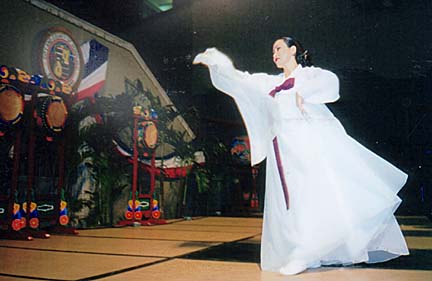


|
The first Koreans in Hawaii disembarked from the ship Gaelic in January, 1903, and as the Centennial Committee of Korean Immigration to the United States busy organizing celebrations to commemmorate that day, we can look forward to a year's worth of cultural activities. Hawaii marks centennial
of first KoreansBy Burl Burlingame
bburlingame@starbulletin.comThis weekend, Daiei stores hosts a 10 a.m. to 6 p.m. Sunday celebration at the Kaheka store, with Waipahu store events following at 11 a.m. to 7 p.m. April 20.
There will be an appearance by Miss Korea 2002; Tae Kwon Do martial-arts demonstrations; Korean dance performances by Nong-Ak Dance group, Halla Huhm Dance Studio, Jung Eun-Sun Dance Studio, Myung-Woo-Dan Dance Group, Choom-Sa-Ran Dance Group and Jang Soo Korean Senior Citizen Group; a Korean fashion show and karaoke contest; cooking demonstrations and food sampling; free bags of rice to the first 200 Kaheka customers; and prize giveaways, including a trip to -- where else?-- Korea!
Call 973-6655 for more information.
If you want a little background behind all the dancing and noshing, relations between the United States and Korea began with a treaty in 1882. The U.S. approved Korean immigration in 1886, followed by a royal OK from Korean Emperor Kojong in 1902.
What followed is known as the "First Wave," a two-year period of Korean emigration to America. The 6,701 Korean men, 677 women, and 465 children, who arrived in Hawaii worked the plantations, and by 1903, the Honolulu Evening Bulletin reported that Koreans "appear to be hard workers, yet they are paid the least ... they work ten hours from dawn to sunset for sixty-nine cents a day."
Between 1912 and 1924, the "Second Wave" consisted of nearly a thousand Korean picture brides, destined for nearly 5,000 Korean bachelors.
The "Third Wave" lasted until 1965, when Koreans trickled into the country as students or the wives of servicemen.
The Immigration Act of 1965, abolishing quotas based on national origin, opened the doors, and some historians divide Korean immigration into Pre-1965 and Post-1965 periods. Between 1976 and 1990, nearly 35,000 Koreans a year emigrated to the U.S., the third largest group behind Mexicans and Filipinos.
Thanks to improved living conditions in South Korea, immigration has dropped off to about 18,000 a year. Most settle in Southern California and the New York-New Jersey area.
Click for online
calendars and events.